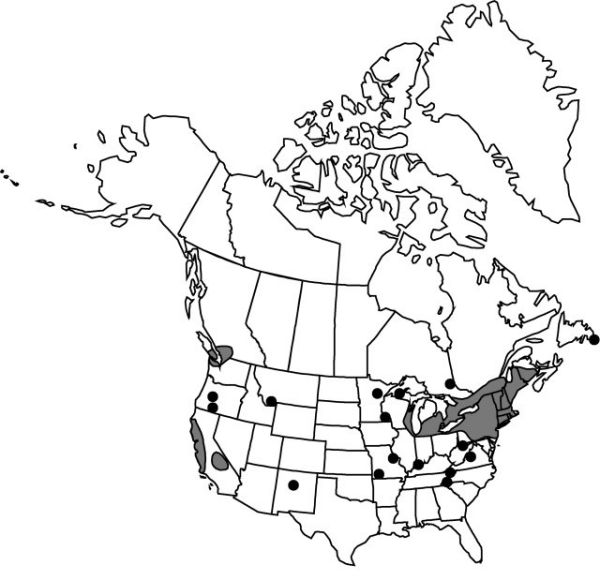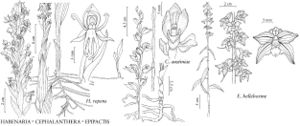Epipactis helleborine
Stirp. Austr. Fasc. ed. 2, 2: 467. 1769.
Plants 25–80(–100) cm, sparsely to densely pubescent. Leaves 3–10, orbiculate, elliptic to narrowly lanceolate, 4–18 × 1.5–8.5 cm. Inflorescences racemes, loose to moderately dense, commonly 1-sided; floral bracts spreading, linear to narrowly lanceolate, 10–40(–70) mm, often exceeding flowers. Flowers 15–50, small; sepals greenish, often suffused with purple; lateral sepals 10–13 × 5–6 mm, apex oblique; petals ovate, pale green, pink, purple, or yellowish, 9–11 × 4–6 mm; lip indistinctly veined, constricted at middle into 2 parts, proximal part purplish to brownish, deeply concave, not papillose, 9–12 × 8 mm, distal part recurved, pink, broadly triangular-ovate, ± flat to tip, 5 × 5 mm; calli 2, near base, brownish, not rugose; column 3–6 mm; ovary glabrous. Capsules obovoid, 9–14 mm, glabrate to densely pubescent. 2n = 36, 38, 40, 44.
Phenology: Flowering Jun–Oct.
Habitat: Moist to dry, rocky, shaded, deciduous to mixed woods, cedar swamps and forested stream margins, often in disturbed places such as lawns, and cracks in concrete sidewalks
Elevation: 0–1300 m
Distribution

Introduced; B.C., N.B., Nfld. and Labr. (Nfld.), Ont., Que., Ark., Calif., Conn., Ill., Ind., Ky., Maine, Md., Mass., Mich., Minn., Mo., Mont., N.H., N.J., N.Mex., N.Y., N.C., Ohio, Oreg., Pa., R.I., Tenn., Vt., Va., Wash., W.Va., Wis., Eurasia, North Africa.
Discussion
Epipactis helleborine is known to have been thoroughly naturalized in North America since 1879 (C. A. Luer 1975).
Extensive and striking color variations in Epipactis helleborine have led to the description of numerous varieties and forms. Most of the varieties originated in Europe, but the following forms originated in North America. With the exception of forma luteola, which has been noted only from Vermont, the other forms occur randomly throughout the range of the species: forma alba (Webster) B. Boivin, white-flowered form; forma luteola P. M. Brown, yellow-flowered; forma monotropoides (Mousley) Scoggan, albino; forma variegata (Webster) B. Boivin, variegated, the leaves with white and cream markings; forma viridens A. Gray, green-flowered.
Selected References
None.
